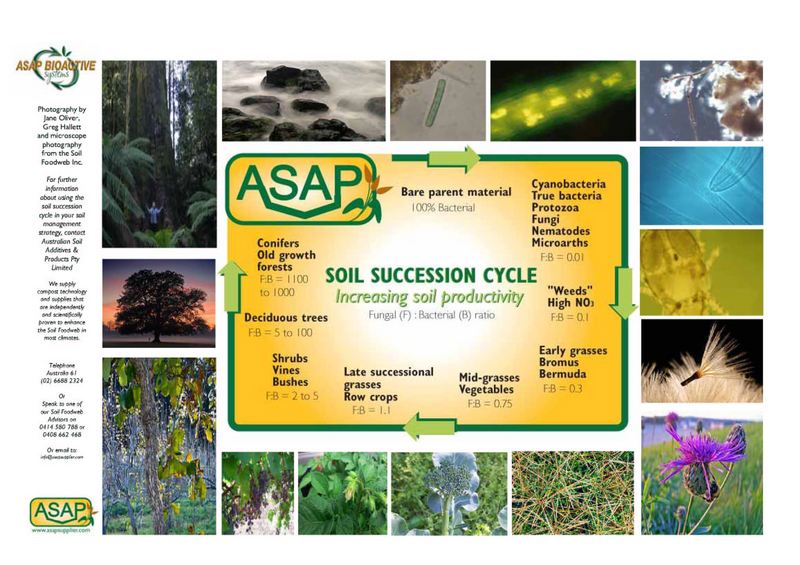Succession and Soil Productivity
When working with soil and water, the science of succession is important to understand. Succession is an ecological term for the more-or-less predictable and orderly series of changes to an ecological community. Succession is often initiated by either the creation of new habitat (e.g. severe landslide or lava flow) or by disturbing an existing community (e.g. fire or logging). These new habitats have a high bacterial level.
As the ecological community ages, soils become more complex and the ratio of fungi to bacteria increases, plant productivity increases, and vegetative communities change. Older habitats have high fungal levels in the soil. As succession proceeds, plant species will tend to be replaced by more competitive species. Succession can be interrupted when held in recession by climate, a catastrophe, or human intervention such as agriculture and mining.
Fungal To Bacterial Ratio's
Find your crop on the Groundgrocer.com Soil Succession diagram pictured below, and then look at the fungi to bacteria ratio (F:B), which is also described by Dr Elaine Ingham in her books. If you are an apple grower, are you managing the trees so as to hold the succession down there at 9 o'clock or is the orchard managed more in grass zone around at 3 o'clock?

How to use soil succession
The diagram shows the progression that naturally occurs, as soils develop and organic matter (carbon) is built up in the soil. Each period has a different fungal/bacterial ratio and is characterised by particular types of plant systems and crops. As the diversity of vegetation increases so does the fungi to bacteria ratios and their complexity and need for additional foods and supporting systems. Measuring the bacterial and fungal levels of your soil can help you work out the successional age of your soil and what it is currently best suited to growing.
Growers, ecologists and property managers can correct unsuitable ratios in the soil’s bacterial:fungal ratio by the use of specific products and management techniques. Good fungal foods include BioActive Fish Hydrolysate and BioActive Liquid Kelp, and the application of BioActive Compost Tea in a controlled manner. This will help stimulate the plants you want to feed and these will have the opportunity to compete properly against less complex plant-life that “regresses” your soil back to simple bacterial life when nature wants it to move forward to forest life!
For those looking to plant seedlings, seeds or young fruit trees in hot, dry paddocks, first think of natural succession (moving from bacterial conditions to fungal) and contact us to discuss preparing the land with improved design and water flows BEFORE adding compost, teas, products or mulches. If you can plan first rather than plant first, this will give more results in the soil after you have spent funds and other energy getting the plants in the ground. If your land management includes burning paddocks to the ground, we can only presume it’s because you have never seen this kind of information. Feedback or queries on this material is very welcome to info@groundgrocer.com.
Armed with this knowledge you can then apply BioActive compost, BioActive compost tea, and/or soil additives to develop the microbial life in your soil to the levels that best suits your growing needs.In order to strengthen or restore your soil’s health to a better fungi:bacteria ratio, and nourish the Soil Foodweb, we recommend the use of a fully tested fish hydrolysate. There are many fish products on the market, but few are proper fungal foods.
 Australian Dollars
Australian Dollars
 US Dollars
US Dollars
 European Euros
European Euros
 New Zealand Dollars
New Zealand Dollars
